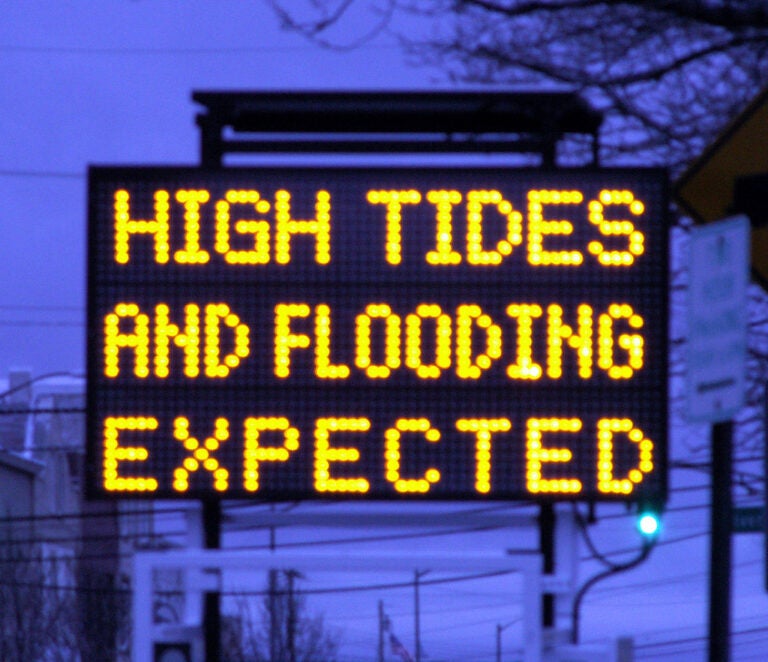N.J. DEP warns environmentalists not to prejudge climate regulation review
Some activists say DEP looks set to allow development in flood-prone areas.

A road sign warns of high tides and expected flooding. (Sister72/Creative Commons)
This story originally appeared on NJ Spotlight.
___
A top environmental official pushed back against attacks from some activists who say the state won’t be doing enough to control development in flood-prone areas when it publishes an overhaul of climate regulations next year.
Shawn LaTourette, deputy commissioner of the Department of Environmental Protection, said it’s too early to draw any conclusions about what regulations on climate adaptation and mitigation will say when they emerge from a current review, called Protecting Against Climate Threats (NJ PACT).
LaTourette said in a recent interview with NJ Spotlight News, the regulations won’t be telling developers where they can and cannot build houses but will instead require them to assess how a proposed property would be affected by climate impacts such as sea-level rise or inland flooding.
That prompted strong protests from some environmentalists who accused DEP of preparing to abandon its responsibilities to protect people and property from the expected ravages of climate change.
Jumping to conclusions?
But in a follow-up interview on Friday, LaTourette said the critics were wrong to conclude that the DEP would leave it up to an individual to decide whether it was safe to build a house in a particular location.
“They have nothing to react to at this point,” he said. “For folks to jump to the conclusion that what we may propose to help ready our state to face this great risk, for folks to presuppose that whatever it is won’t be good enough, that’s not following the science.”
LaTourette’s first remarks included this: “We are not saying: ‘You cannot build in a future flood-risk area.’”
Jeff Tittel, director of the New Jersey Sierra Club, said the earlier comments suggested that the new rules would mean the state deciding not to regulate land use in areas that would be subject to future flooding.
‘The hell with flooding …’
“I was shocked when I read it,” Tittel said. “I couldn’t believe that someone who’s in charge of DEP’s programs, who oversees coastal programs and land use, would make such a brazen statement that seems just to turn the state over to developers, and the hell with the environment, and the hell with flooding and putting people in harm’s way.”
Bill Wolfe, a retired DEP policy analyst and the current author of an environmental blog, said the comments “reflect an astonishing abdication of DEP’s regulatory responsibilities,” particularly coming from an administration that claims to be a leader in battling climate change.
“DEP must regulate to achieve deep emissions reductions and reduce risks as clearly reflected by an overwhelming scientific consensus,” Wolfe said. “Delay only makes matters worse.”
Wolfe argued that the DEP is required to regulate development under several laws, including the Flood Hazard Area Control Act and the Coastal Area Facilities Review Act.
Jennifer Coffey, executive director of the Association of New Jersey Environmental Commissions, said she had been concerned about what the new regulations would say, after reading LaTourette’s earlier comments, but feels more comfortable after speaking with him.
“I am confident that the DEP is going to be proposing concrete actions under NJ PACT to mitigate the impacts of climate change and to reduce greenhouse-gas emissions,” she said.
N.J.’s rising sea level
Sea level at the Jersey Shore is expected to rise by up to 1.1 feet by 2030 and up to 2.1 feet by 2050 compared with its 2000 level, according to a report from the DEP and Rutgers University last November. Inland, some areas are expected to flood more often because of heavier precipitation that’s forecast to come with climate change.
The expected effects of rising seas include much more frequent flooding at Atlantic City, which is likely to experience 17 to 75 high-tide flooding days a year by 2030 under a likely sea-level rise scenario, compared with eight in 2016 and only one in the 1950s, the report said.
In his latest remarks, LaTourette said the nature of the proposed regulations will become clearer in the coming weeks when the DEP plans to publish an outline of the regulations.
Expect ‘roadmap’ before rules released
“Within the next several weeks, certainly before the end of the year, we will lay out a road map that folks can respond to, that we can take more comment on, before a rule is proposed,” he said. “It is the next phase in stakeholdering these important concepts.”
The public will have another opportunity to comment when the proposed rules are published early next year, he said, but they too will be part of an evolving response to the climate crisis.
“What we propose next year in terms of actual rule text — at which time folks can have any array of reactions — that’s the time for suggesting ‘Is it good enough or is it not?’” he said. “But even then, it is one more step in this iterative process of how we prepare for this crisis.”
When they are published, the proposed regulations will be site-specific and time-specific, LaTourette said. Flood-risk scenarios will depend on how far in the future the forecast applies. Until 2050, projections can be made with “considerable confidence” because they can’t be influenced by mitigation now, but flooding forecasts beyond that will depend on how much the world is able to curb climate-emissions in the short term, he said.
Avoiding lawsuits
If the DEP is taking an incremental approach to climate regulation now, that’s because it can’t afford the lawsuits that it would attract if it issued strict rules on development in future flood zones, argued Sen. Bob Smith (D-Middlesex), chairman of the Senate Environment and Energy Committee.
Smith, who frequently warns about the dangers of rising seas at the Shore, said any move by DEP to prevent development of future flood zones would prompt “inverse condemnation” suits claiming that the government has taken private property without compensating the owner, who is therefore entitled to payment.
“If the department took the position that ‘we’re going to tell people where they can and can’t build’, that’s inverse condemnation and you’ve got to have the bucks to back it up,” he said. “To take the role that some people would like to see them take, they don’t have the resources to do it.”
He said the DEP is taking a limited approach to new climate regulation for now, in hope of convincing the public that stronger measures will be needed later.
“This at least starts it,” he said. “They are putting out there, on record, this piece of property, it’s got a problem, and if you’re going to build there, you better plan on building high. So they have the ability with this first level of evolution to say: ‘I told you so.’”
Still, Smith predicted that at some point, the regulations that require people and property to avoid flood-prone areas will be “very, very harsh.” Climate change may also force the state or municipalities to change building codes so that any new houses in flood zones are built higher, he said.
And he said if the DEP plans now to alert property owners to the flood dangers of a certain site, and then let them decide whether to build there, it won’t reflect the realities of the changing climate.
“I don’t think it’s going to be enough to provide the information and the guidelines,” Smith said. “Not everybody is altruistic or thinks in the current moment what is really in their best long-term interests. Their view is very short term, and it’s very hard for them to do the right thing.”
WHYY is your source for fact-based, in-depth journalism and information. As a nonprofit organization, we rely on financial support from readers like you. Please give today.




